Factors Impacting Pain Management for Dementia Patients in Hospitals
VerifiedAdded on 2020/06/06
|20
|9175
|252
Report
AI Summary
This report investigates the factors affecting effective pain management for individuals with dementia in an acute hospital setting. The introduction highlights the prevalence of pain in elderly adults with dementia, the challenges in pain recognition and management due to cognitive impairment, and the impact of inadequate healthcare professional skills and organizational support. The paper aims to identify methods of pain recognition, assessment, and management, and develop decision support interventions for nurses. The background section provides statistics on dementia prevalence and its impact on individuals, families, and healthcare costs, emphasizing the need for improved dementia care training for healthcare staff. The report discusses the challenges nurses face in recognizing, assessing, and managing pain in dementia patients, due to communication difficulties, misinterpretation of pain indicators, and the need for more training in this area. A systematic literature search was conducted using CINAHL, PubMed, and ScienceDirect, with the search terms including pain recognition, pain assessment, pain management, people with dementia, and hospital acute setting. The research articles selected for analysis cover the period between 2010 and September 2017. The report will then explore the methodology, findings, discussion, and conclusions to provide recommendations for improving pain management practices. The challenges faced by nursing staff in recognizing, assessing and managing the pain experiences of dementia patients are also discussed.
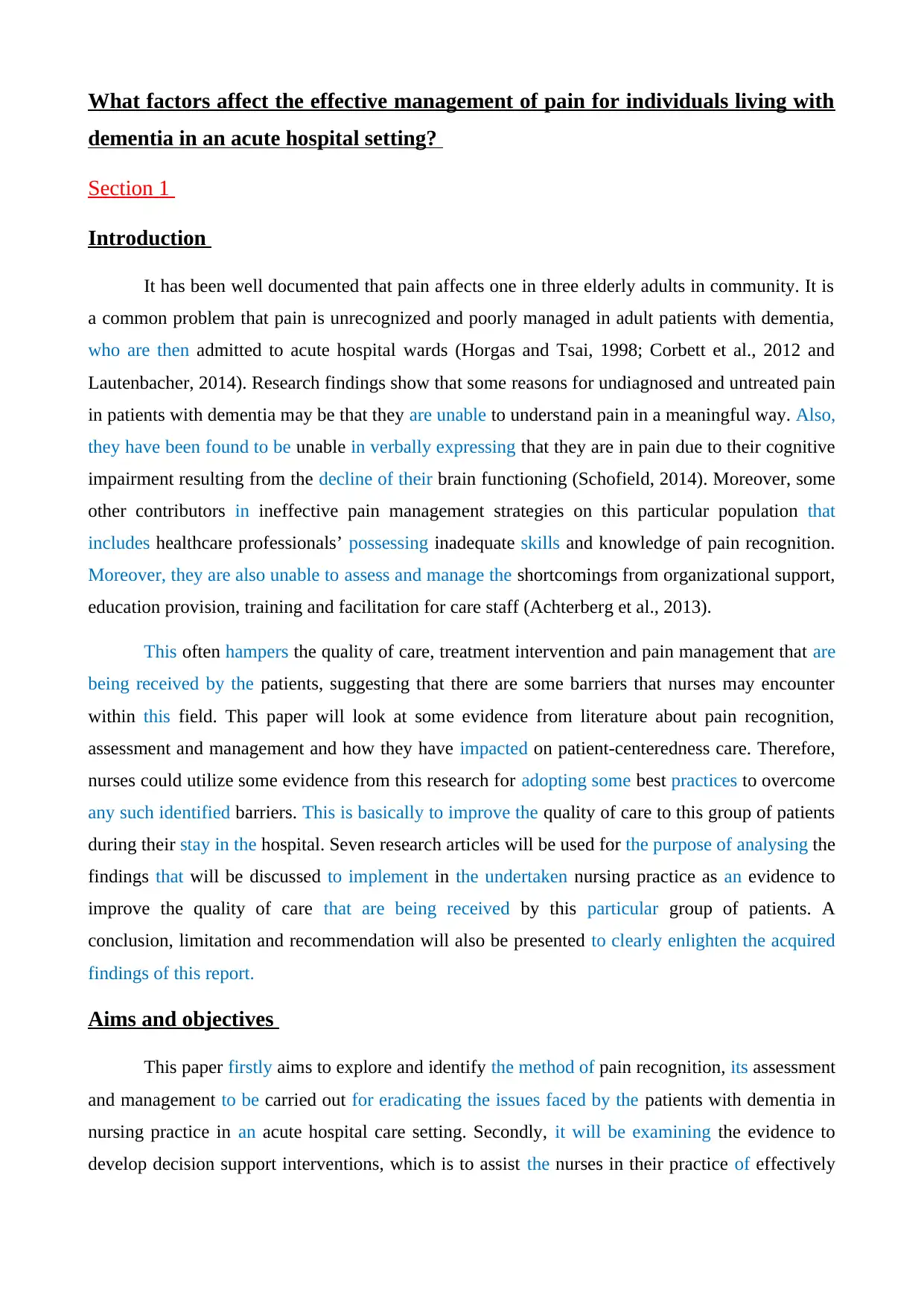
What factors affect the effective management of pain for individuals living with
dementia in an acute hospital setting?
Section 1
Introduction
It has been well documented that pain affects one in three elderly adults in community. It is
a common problem that pain is unrecognized and poorly managed in adult patients with dementia,
who are then admitted to acute hospital wards (Horgas and Tsai, 1998; Corbett et al., 2012 and
Lautenbacher, 2014). Research findings show that some reasons for undiagnosed and untreated pain
in patients with dementia may be that they are unable to understand pain in a meaningful way. Also,
they have been found to be unable in verbally expressing that they are in pain due to their cognitive
impairment resulting from the decline of their brain functioning (Schofield, 2014). Moreover, some
other contributors in ineffective pain management strategies on this particular population that
includes healthcare professionals’ possessing inadequate skills and knowledge of pain recognition.
Moreover, they are also unable to assess and manage the shortcomings from organizational support,
education provision, training and facilitation for care staff (Achterberg et al., 2013).
This often hampers the quality of care, treatment intervention and pain management that are
being received by the patients, suggesting that there are some barriers that nurses may encounter
within this field. This paper will look at some evidence from literature about pain recognition,
assessment and management and how they have impacted on patient-centeredness care. Therefore,
nurses could utilize some evidence from this research for adopting some best practices to overcome
any such identified barriers. This is basically to improve the quality of care to this group of patients
during their stay in the hospital. Seven research articles will be used for the purpose of analysing the
findings that will be discussed to implement in the undertaken nursing practice as an evidence to
improve the quality of care that are being received by this particular group of patients. A
conclusion, limitation and recommendation will also be presented to clearly enlighten the acquired
findings of this report.
Aims and objectives
This paper firstly aims to explore and identify the method of pain recognition, its assessment
and management to be carried out for eradicating the issues faced by the patients with dementia in
nursing practice in an acute hospital care setting. Secondly, it will be examining the evidence to
develop decision support interventions, which is to assist the nurses in their practice of effectively
dementia in an acute hospital setting?
Section 1
Introduction
It has been well documented that pain affects one in three elderly adults in community. It is
a common problem that pain is unrecognized and poorly managed in adult patients with dementia,
who are then admitted to acute hospital wards (Horgas and Tsai, 1998; Corbett et al., 2012 and
Lautenbacher, 2014). Research findings show that some reasons for undiagnosed and untreated pain
in patients with dementia may be that they are unable to understand pain in a meaningful way. Also,
they have been found to be unable in verbally expressing that they are in pain due to their cognitive
impairment resulting from the decline of their brain functioning (Schofield, 2014). Moreover, some
other contributors in ineffective pain management strategies on this particular population that
includes healthcare professionals’ possessing inadequate skills and knowledge of pain recognition.
Moreover, they are also unable to assess and manage the shortcomings from organizational support,
education provision, training and facilitation for care staff (Achterberg et al., 2013).
This often hampers the quality of care, treatment intervention and pain management that are
being received by the patients, suggesting that there are some barriers that nurses may encounter
within this field. This paper will look at some evidence from literature about pain recognition,
assessment and management and how they have impacted on patient-centeredness care. Therefore,
nurses could utilize some evidence from this research for adopting some best practices to overcome
any such identified barriers. This is basically to improve the quality of care to this group of patients
during their stay in the hospital. Seven research articles will be used for the purpose of analysing the
findings that will be discussed to implement in the undertaken nursing practice as an evidence to
improve the quality of care that are being received by this particular group of patients. A
conclusion, limitation and recommendation will also be presented to clearly enlighten the acquired
findings of this report.
Aims and objectives
This paper firstly aims to explore and identify the method of pain recognition, its assessment
and management to be carried out for eradicating the issues faced by the patients with dementia in
nursing practice in an acute hospital care setting. Secondly, it will be examining the evidence to
develop decision support interventions, which is to assist the nurses in their practice of effectively
Paraphrase This Document
Need a fresh take? Get an instant paraphrase of this document with our AI Paraphraser
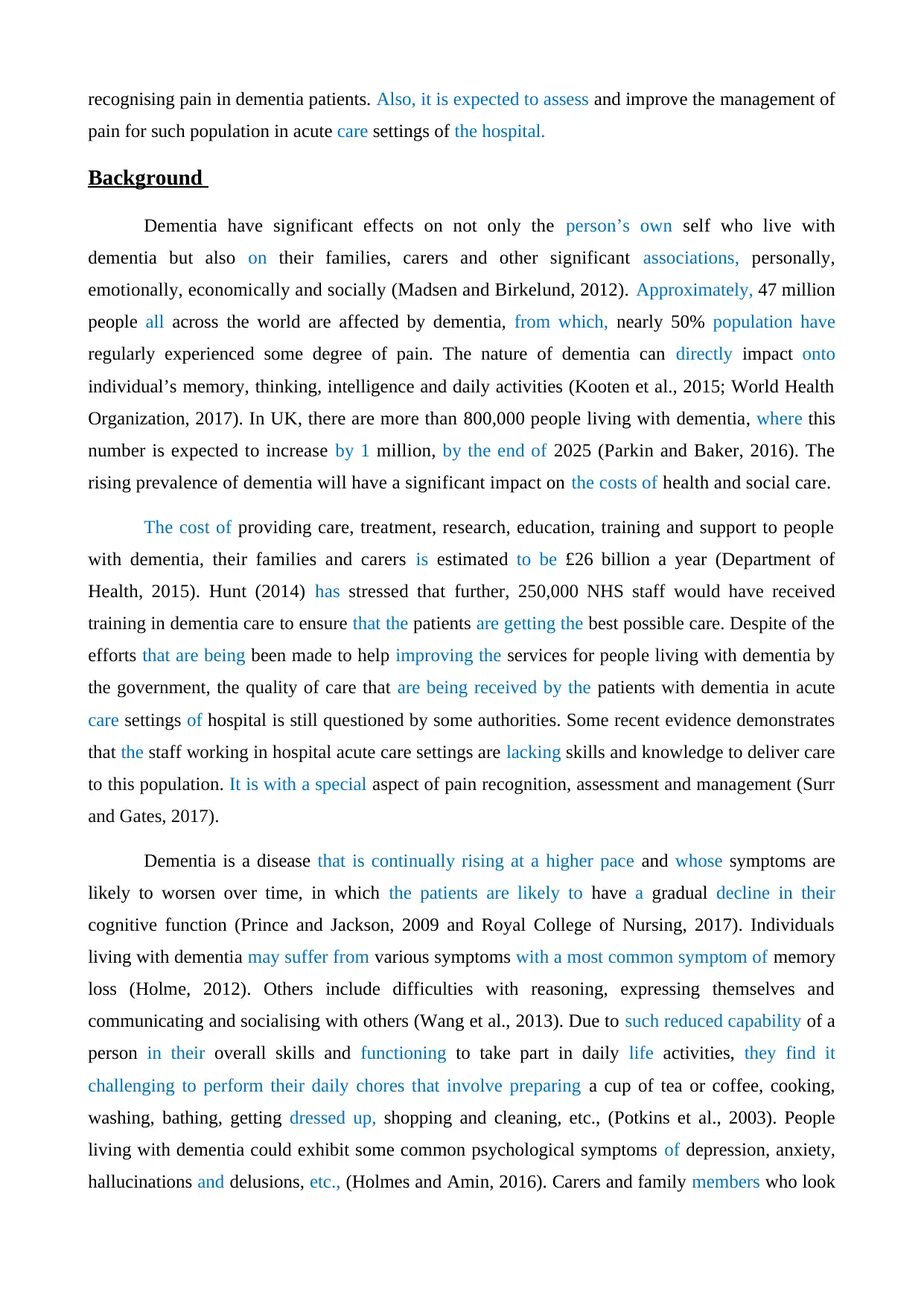
recognising pain in dementia patients. Also, it is expected to assess and improve the management of
pain for such population in acute care settings of the hospital.
Background
Dementia have significant effects on not only the person’s own self who live with
dementia but also on their families, carers and other significant associations, personally,
emotionally, economically and socially (Madsen and Birkelund, 2012). Approximately, 47 million
people all across the world are affected by dementia, from which, nearly 50% population have
regularly experienced some degree of pain. The nature of dementia can directly impact onto
individual’s memory, thinking, intelligence and daily activities (Kooten et al., 2015; World Health
Organization, 2017). In UK, there are more than 800,000 people living with dementia, where this
number is expected to increase by 1 million, by the end of 2025 (Parkin and Baker, 2016). The
rising prevalence of dementia will have a significant impact on the costs of health and social care.
The cost of providing care, treatment, research, education, training and support to people
with dementia, their families and carers is estimated to be £26 billion a year (Department of
Health, 2015). Hunt (2014) has stressed that further, 250,000 NHS staff would have received
training in dementia care to ensure that the patients are getting the best possible care. Despite of the
efforts that are being been made to help improving the services for people living with dementia by
the government, the quality of care that are being received by the patients with dementia in acute
care settings of hospital is still questioned by some authorities. Some recent evidence demonstrates
that the staff working in hospital acute care settings are lacking skills and knowledge to deliver care
to this population. It is with a special aspect of pain recognition, assessment and management (Surr
and Gates, 2017).
Dementia is a disease that is continually rising at a higher pace and whose symptoms are
likely to worsen over time, in which the patients are likely to have a gradual decline in their
cognitive function (Prince and Jackson, 2009 and Royal College of Nursing, 2017). Individuals
living with dementia may suffer from various symptoms with a most common symptom of memory
loss (Holme, 2012). Others include difficulties with reasoning, expressing themselves and
communicating and socialising with others (Wang et al., 2013). Due to such reduced capability of a
person in their overall skills and functioning to take part in daily life activities, they find it
challenging to perform their daily chores that involve preparing a cup of tea or coffee, cooking,
washing, bathing, getting dressed up, shopping and cleaning, etc., (Potkins et al., 2003). People
living with dementia could exhibit some common psychological symptoms of depression, anxiety,
hallucinations and delusions, etc., (Holmes and Amin, 2016). Carers and family members who look
pain for such population in acute care settings of the hospital.
Background
Dementia have significant effects on not only the person’s own self who live with
dementia but also on their families, carers and other significant associations, personally,
emotionally, economically and socially (Madsen and Birkelund, 2012). Approximately, 47 million
people all across the world are affected by dementia, from which, nearly 50% population have
regularly experienced some degree of pain. The nature of dementia can directly impact onto
individual’s memory, thinking, intelligence and daily activities (Kooten et al., 2015; World Health
Organization, 2017). In UK, there are more than 800,000 people living with dementia, where this
number is expected to increase by 1 million, by the end of 2025 (Parkin and Baker, 2016). The
rising prevalence of dementia will have a significant impact on the costs of health and social care.
The cost of providing care, treatment, research, education, training and support to people
with dementia, their families and carers is estimated to be £26 billion a year (Department of
Health, 2015). Hunt (2014) has stressed that further, 250,000 NHS staff would have received
training in dementia care to ensure that the patients are getting the best possible care. Despite of the
efforts that are being been made to help improving the services for people living with dementia by
the government, the quality of care that are being received by the patients with dementia in acute
care settings of hospital is still questioned by some authorities. Some recent evidence demonstrates
that the staff working in hospital acute care settings are lacking skills and knowledge to deliver care
to this population. It is with a special aspect of pain recognition, assessment and management (Surr
and Gates, 2017).
Dementia is a disease that is continually rising at a higher pace and whose symptoms are
likely to worsen over time, in which the patients are likely to have a gradual decline in their
cognitive function (Prince and Jackson, 2009 and Royal College of Nursing, 2017). Individuals
living with dementia may suffer from various symptoms with a most common symptom of memory
loss (Holme, 2012). Others include difficulties with reasoning, expressing themselves and
communicating and socialising with others (Wang et al., 2013). Due to such reduced capability of a
person in their overall skills and functioning to take part in daily life activities, they find it
challenging to perform their daily chores that involve preparing a cup of tea or coffee, cooking,
washing, bathing, getting dressed up, shopping and cleaning, etc., (Potkins et al., 2003). People
living with dementia could exhibit some common psychological symptoms of depression, anxiety,
hallucinations and delusions, etc., (Holmes and Amin, 2016). Carers and family members who look
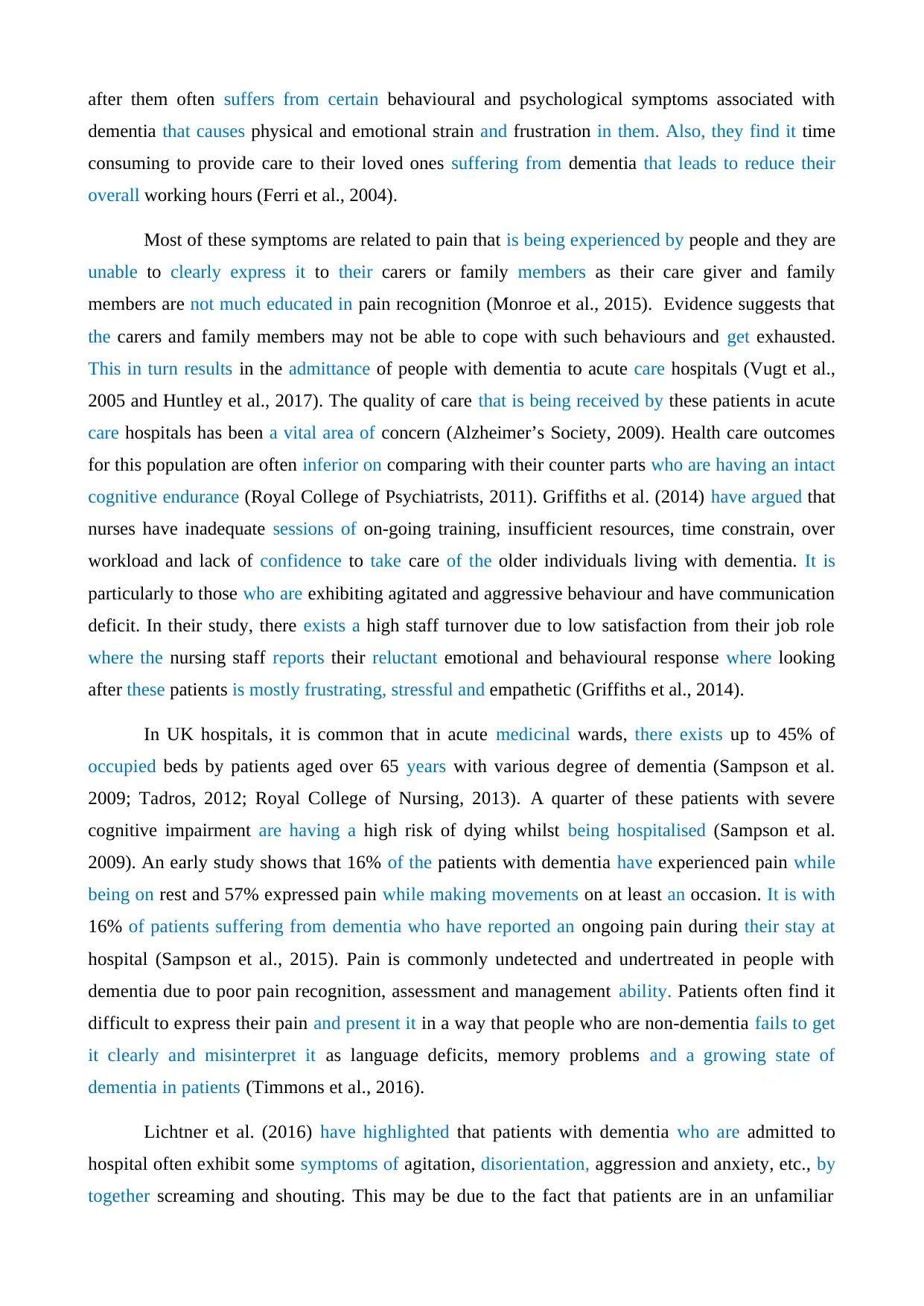
after them often suffers from certain behavioural and psychological symptoms associated with
dementia that causes physical and emotional strain and frustration in them. Also, they find it time
consuming to provide care to their loved ones suffering from dementia that leads to reduce their
overall working hours (Ferri et al., 2004).
Most of these symptoms are related to pain that is being experienced by people and they are
unable to clearly express it to their carers or family members as their care giver and family
members are not much educated in pain recognition (Monroe et al., 2015). Evidence suggests that
the carers and family members may not be able to cope with such behaviours and get exhausted.
This in turn results in the admittance of people with dementia to acute care hospitals (Vugt et al.,
2005 and Huntley et al., 2017). The quality of care that is being received by these patients in acute
care hospitals has been a vital area of concern (Alzheimer’s Society, 2009). Health care outcomes
for this population are often inferior on comparing with their counter parts who are having an intact
cognitive endurance (Royal College of Psychiatrists, 2011). Griffiths et al. (2014) have argued that
nurses have inadequate sessions of on-going training, insufficient resources, time constrain, over
workload and lack of confidence to take care of the older individuals living with dementia. It is
particularly to those who are exhibiting agitated and aggressive behaviour and have communication
deficit. In their study, there exists a high staff turnover due to low satisfaction from their job role
where the nursing staff reports their reluctant emotional and behavioural response where looking
after these patients is mostly frustrating, stressful and empathetic (Griffiths et al., 2014).
In UK hospitals, it is common that in acute medicinal wards, there exists up to 45% of
occupied beds by patients aged over 65 years with various degree of dementia (Sampson et al.
2009; Tadros, 2012; Royal College of Nursing, 2013). A quarter of these patients with severe
cognitive impairment are having a high risk of dying whilst being hospitalised (Sampson et al.
2009). An early study shows that 16% of the patients with dementia have experienced pain while
being on rest and 57% expressed pain while making movements on at least an occasion. It is with
16% of patients suffering from dementia who have reported an ongoing pain during their stay at
hospital (Sampson et al., 2015). Pain is commonly undetected and undertreated in people with
dementia due to poor pain recognition, assessment and management ability. Patients often find it
difficult to express their pain and present it in a way that people who are non-dementia fails to get
it clearly and misinterpret it as language deficits, memory problems and a growing state of
dementia in patients (Timmons et al., 2016).
Lichtner et al. (2016) have highlighted that patients with dementia who are admitted to
hospital often exhibit some symptoms of agitation, disorientation, aggression and anxiety, etc., by
together screaming and shouting. This may be due to the fact that patients are in an unfamiliar
dementia that causes physical and emotional strain and frustration in them. Also, they find it time
consuming to provide care to their loved ones suffering from dementia that leads to reduce their
overall working hours (Ferri et al., 2004).
Most of these symptoms are related to pain that is being experienced by people and they are
unable to clearly express it to their carers or family members as their care giver and family
members are not much educated in pain recognition (Monroe et al., 2015). Evidence suggests that
the carers and family members may not be able to cope with such behaviours and get exhausted.
This in turn results in the admittance of people with dementia to acute care hospitals (Vugt et al.,
2005 and Huntley et al., 2017). The quality of care that is being received by these patients in acute
care hospitals has been a vital area of concern (Alzheimer’s Society, 2009). Health care outcomes
for this population are often inferior on comparing with their counter parts who are having an intact
cognitive endurance (Royal College of Psychiatrists, 2011). Griffiths et al. (2014) have argued that
nurses have inadequate sessions of on-going training, insufficient resources, time constrain, over
workload and lack of confidence to take care of the older individuals living with dementia. It is
particularly to those who are exhibiting agitated and aggressive behaviour and have communication
deficit. In their study, there exists a high staff turnover due to low satisfaction from their job role
where the nursing staff reports their reluctant emotional and behavioural response where looking
after these patients is mostly frustrating, stressful and empathetic (Griffiths et al., 2014).
In UK hospitals, it is common that in acute medicinal wards, there exists up to 45% of
occupied beds by patients aged over 65 years with various degree of dementia (Sampson et al.
2009; Tadros, 2012; Royal College of Nursing, 2013). A quarter of these patients with severe
cognitive impairment are having a high risk of dying whilst being hospitalised (Sampson et al.
2009). An early study shows that 16% of the patients with dementia have experienced pain while
being on rest and 57% expressed pain while making movements on at least an occasion. It is with
16% of patients suffering from dementia who have reported an ongoing pain during their stay at
hospital (Sampson et al., 2015). Pain is commonly undetected and undertreated in people with
dementia due to poor pain recognition, assessment and management ability. Patients often find it
difficult to express their pain and present it in a way that people who are non-dementia fails to get
it clearly and misinterpret it as language deficits, memory problems and a growing state of
dementia in patients (Timmons et al., 2016).
Lichtner et al. (2016) have highlighted that patients with dementia who are admitted to
hospital often exhibit some symptoms of agitation, disorientation, aggression and anxiety, etc., by
together screaming and shouting. This may be due to the fact that patients are in an unfamiliar
⊘ This is a preview!⊘
Do you want full access?
Subscribe today to unlock all pages.

Trusted by 1+ million students worldwide
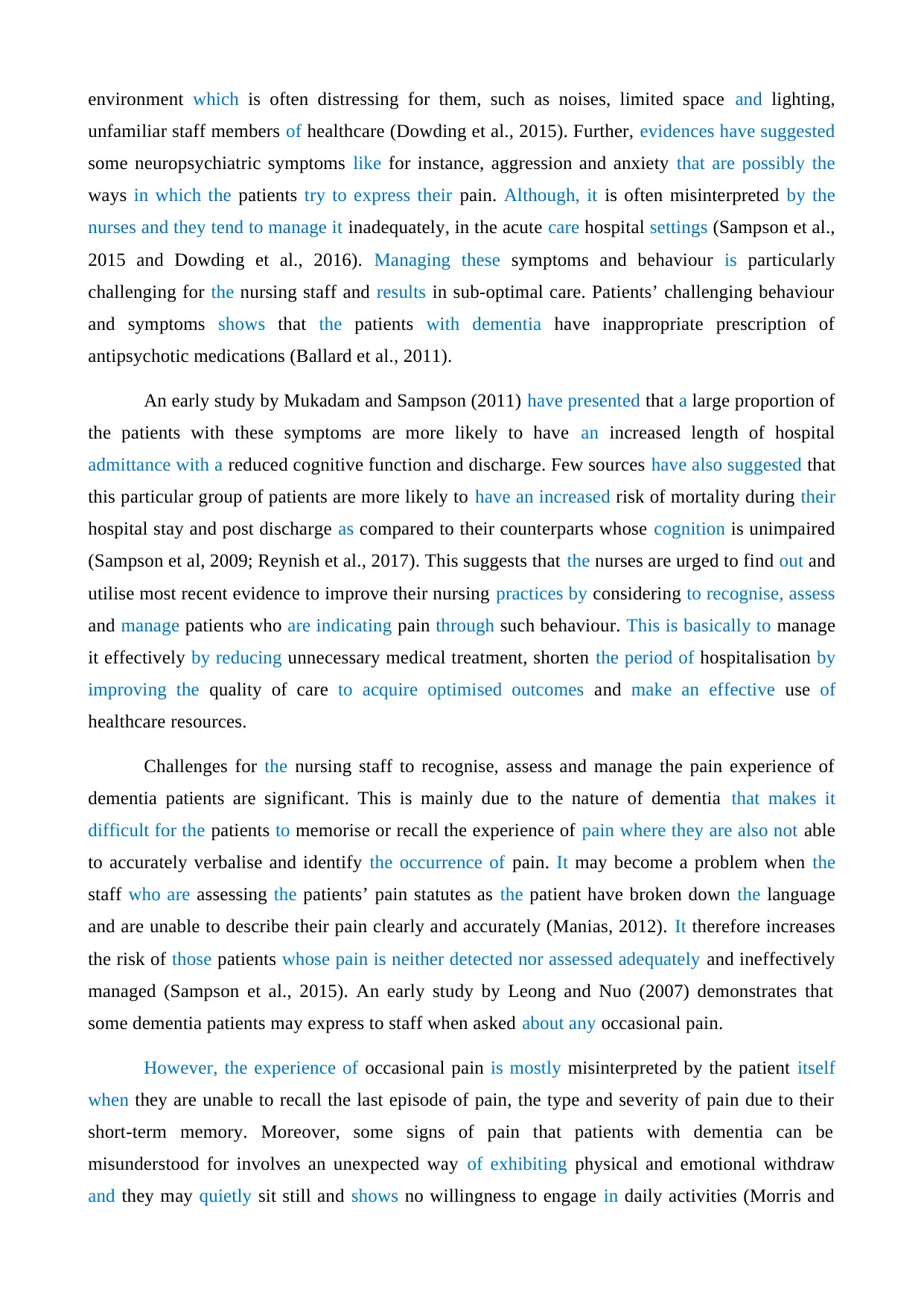
environment which is often distressing for them, such as noises, limited space and lighting,
unfamiliar staff members of healthcare (Dowding et al., 2015). Further, evidences have suggested
some neuropsychiatric symptoms like for instance, aggression and anxiety that are possibly the
ways in which the patients try to express their pain. Although, it is often misinterpreted by the
nurses and they tend to manage it inadequately, in the acute care hospital settings (Sampson et al.,
2015 and Dowding et al., 2016). Managing these symptoms and behaviour is particularly
challenging for the nursing staff and results in sub-optimal care. Patients’ challenging behaviour
and symptoms shows that the patients with dementia have inappropriate prescription of
antipsychotic medications (Ballard et al., 2011).
An early study by Mukadam and Sampson (2011) have presented that a large proportion of
the patients with these symptoms are more likely to have an increased length of hospital
admittance with a reduced cognitive function and discharge. Few sources have also suggested that
this particular group of patients are more likely to have an increased risk of mortality during their
hospital stay and post discharge as compared to their counterparts whose cognition is unimpaired
(Sampson et al, 2009; Reynish et al., 2017). This suggests that the nurses are urged to find out and
utilise most recent evidence to improve their nursing practices by considering to recognise, assess
and manage patients who are indicating pain through such behaviour. This is basically to manage
it effectively by reducing unnecessary medical treatment, shorten the period of hospitalisation by
improving the quality of care to acquire optimised outcomes and make an effective use of
healthcare resources.
Challenges for the nursing staff to recognise, assess and manage the pain experience of
dementia patients are significant. This is mainly due to the nature of dementia that makes it
difficult for the patients to memorise or recall the experience of pain where they are also not able
to accurately verbalise and identify the occurrence of pain. It may become a problem when the
staff who are assessing the patients’ pain statutes as the patient have broken down the language
and are unable to describe their pain clearly and accurately (Manias, 2012). It therefore increases
the risk of those patients whose pain is neither detected nor assessed adequately and ineffectively
managed (Sampson et al., 2015). An early study by Leong and Nuo (2007) demonstrates that
some dementia patients may express to staff when asked about any occasional pain.
However, the experience of occasional pain is mostly misinterpreted by the patient itself
when they are unable to recall the last episode of pain, the type and severity of pain due to their
short-term memory. Moreover, some signs of pain that patients with dementia can be
misunderstood for involves an unexpected way of exhibiting physical and emotional withdraw
and they may quietly sit still and shows no willingness to engage in daily activities (Morris and
unfamiliar staff members of healthcare (Dowding et al., 2015). Further, evidences have suggested
some neuropsychiatric symptoms like for instance, aggression and anxiety that are possibly the
ways in which the patients try to express their pain. Although, it is often misinterpreted by the
nurses and they tend to manage it inadequately, in the acute care hospital settings (Sampson et al.,
2015 and Dowding et al., 2016). Managing these symptoms and behaviour is particularly
challenging for the nursing staff and results in sub-optimal care. Patients’ challenging behaviour
and symptoms shows that the patients with dementia have inappropriate prescription of
antipsychotic medications (Ballard et al., 2011).
An early study by Mukadam and Sampson (2011) have presented that a large proportion of
the patients with these symptoms are more likely to have an increased length of hospital
admittance with a reduced cognitive function and discharge. Few sources have also suggested that
this particular group of patients are more likely to have an increased risk of mortality during their
hospital stay and post discharge as compared to their counterparts whose cognition is unimpaired
(Sampson et al, 2009; Reynish et al., 2017). This suggests that the nurses are urged to find out and
utilise most recent evidence to improve their nursing practices by considering to recognise, assess
and manage patients who are indicating pain through such behaviour. This is basically to manage
it effectively by reducing unnecessary medical treatment, shorten the period of hospitalisation by
improving the quality of care to acquire optimised outcomes and make an effective use of
healthcare resources.
Challenges for the nursing staff to recognise, assess and manage the pain experience of
dementia patients are significant. This is mainly due to the nature of dementia that makes it
difficult for the patients to memorise or recall the experience of pain where they are also not able
to accurately verbalise and identify the occurrence of pain. It may become a problem when the
staff who are assessing the patients’ pain statutes as the patient have broken down the language
and are unable to describe their pain clearly and accurately (Manias, 2012). It therefore increases
the risk of those patients whose pain is neither detected nor assessed adequately and ineffectively
managed (Sampson et al., 2015). An early study by Leong and Nuo (2007) demonstrates that
some dementia patients may express to staff when asked about any occasional pain.
However, the experience of occasional pain is mostly misinterpreted by the patient itself
when they are unable to recall the last episode of pain, the type and severity of pain due to their
short-term memory. Moreover, some signs of pain that patients with dementia can be
misunderstood for involves an unexpected way of exhibiting physical and emotional withdraw
and they may quietly sit still and shows no willingness to engage in daily activities (Morris and
Paraphrase This Document
Need a fresh take? Get an instant paraphrase of this document with our AI Paraphraser

Morris, 2010). This suggests that it could be challenging for the staff to recognise whether the
patient is in pain or not. When nursing staff sees a patient seems to be settled by being quiet, they
assume that the patient has no such complaint of pain and thus do not provide any prescribed
medication for pain.
patient is in pain or not. When nursing staff sees a patient seems to be settled by being quiet, they
assume that the patient has no such complaint of pain and thus do not provide any prescribed
medication for pain.
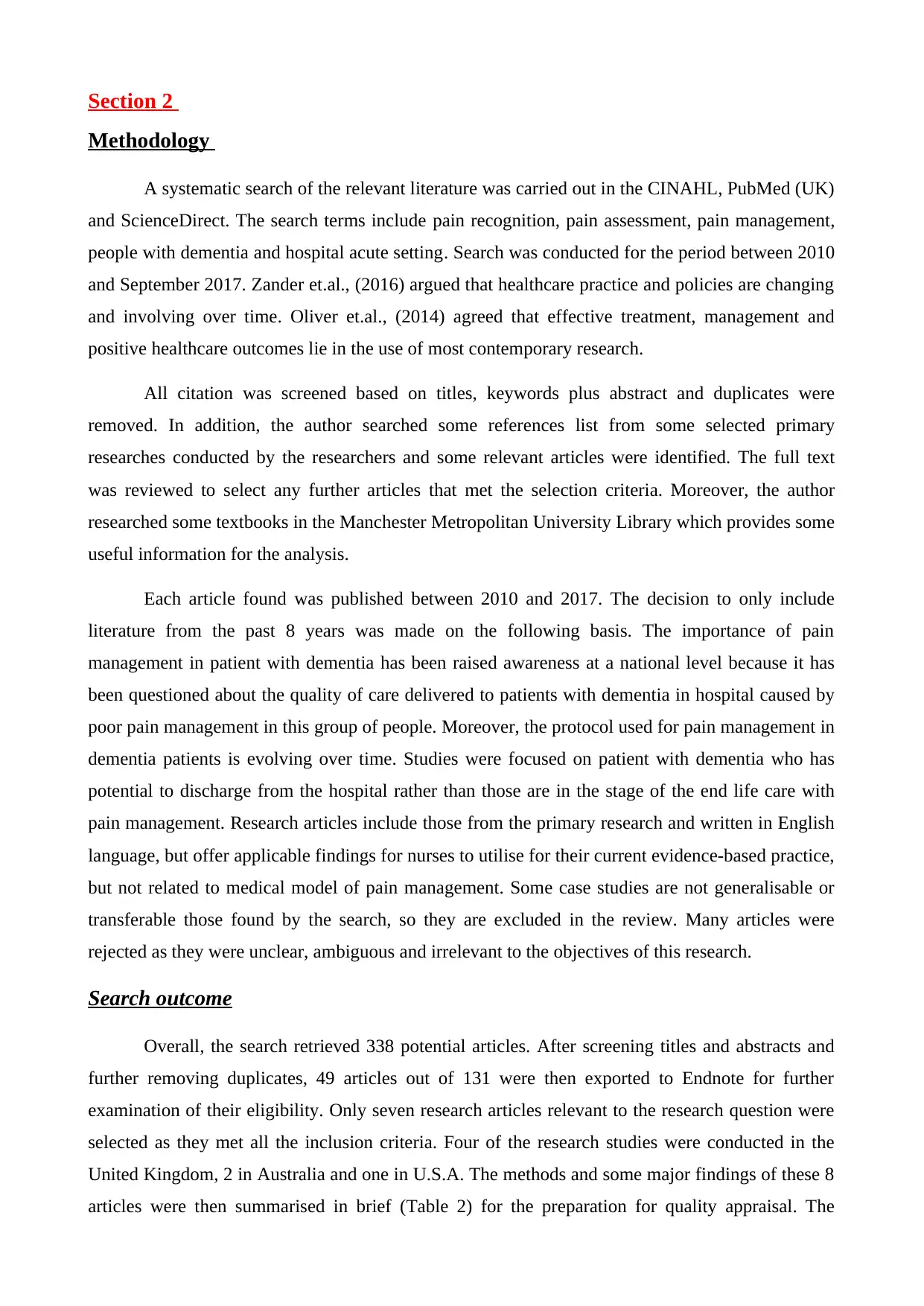
Section 2
Methodology
A systematic search of the relevant literature was carried out in the CINAHL, PubMed (UK)
and ScienceDirect. The search terms include pain recognition, pain assessment, pain management,
people with dementia and hospital acute setting. Search was conducted for the period between 2010
and September 2017. Zander et.al., (2016) argued that healthcare practice and policies are changing
and involving over time. Oliver et.al., (2014) agreed that effective treatment, management and
positive healthcare outcomes lie in the use of most contemporary research.
All citation was screened based on titles, keywords plus abstract and duplicates were
removed. In addition, the author searched some references list from some selected primary
researches conducted by the researchers and some relevant articles were identified. The full text
was reviewed to select any further articles that met the selection criteria. Moreover, the author
researched some textbooks in the Manchester Metropolitan University Library which provides some
useful information for the analysis.
Each article found was published between 2010 and 2017. The decision to only include
literature from the past 8 years was made on the following basis. The importance of pain
management in patient with dementia has been raised awareness at a national level because it has
been questioned about the quality of care delivered to patients with dementia in hospital caused by
poor pain management in this group of people. Moreover, the protocol used for pain management in
dementia patients is evolving over time. Studies were focused on patient with dementia who has
potential to discharge from the hospital rather than those are in the stage of the end life care with
pain management. Research articles include those from the primary research and written in English
language, but offer applicable findings for nurses to utilise for their current evidence-based practice,
but not related to medical model of pain management. Some case studies are not generalisable or
transferable those found by the search, so they are excluded in the review. Many articles were
rejected as they were unclear, ambiguous and irrelevant to the objectives of this research.
Search outcome
Overall, the search retrieved 338 potential articles. After screening titles and abstracts and
further removing duplicates, 49 articles out of 131 were then exported to Endnote for further
examination of their eligibility. Only seven research articles relevant to the research question were
selected as they met all the inclusion criteria. Four of the research studies were conducted in the
United Kingdom, 2 in Australia and one in U.S.A. The methods and some major findings of these 8
articles were then summarised in brief (Table 2) for the preparation for quality appraisal. The
Methodology
A systematic search of the relevant literature was carried out in the CINAHL, PubMed (UK)
and ScienceDirect. The search terms include pain recognition, pain assessment, pain management,
people with dementia and hospital acute setting. Search was conducted for the period between 2010
and September 2017. Zander et.al., (2016) argued that healthcare practice and policies are changing
and involving over time. Oliver et.al., (2014) agreed that effective treatment, management and
positive healthcare outcomes lie in the use of most contemporary research.
All citation was screened based on titles, keywords plus abstract and duplicates were
removed. In addition, the author searched some references list from some selected primary
researches conducted by the researchers and some relevant articles were identified. The full text
was reviewed to select any further articles that met the selection criteria. Moreover, the author
researched some textbooks in the Manchester Metropolitan University Library which provides some
useful information for the analysis.
Each article found was published between 2010 and 2017. The decision to only include
literature from the past 8 years was made on the following basis. The importance of pain
management in patient with dementia has been raised awareness at a national level because it has
been questioned about the quality of care delivered to patients with dementia in hospital caused by
poor pain management in this group of people. Moreover, the protocol used for pain management in
dementia patients is evolving over time. Studies were focused on patient with dementia who has
potential to discharge from the hospital rather than those are in the stage of the end life care with
pain management. Research articles include those from the primary research and written in English
language, but offer applicable findings for nurses to utilise for their current evidence-based practice,
but not related to medical model of pain management. Some case studies are not generalisable or
transferable those found by the search, so they are excluded in the review. Many articles were
rejected as they were unclear, ambiguous and irrelevant to the objectives of this research.
Search outcome
Overall, the search retrieved 338 potential articles. After screening titles and abstracts and
further removing duplicates, 49 articles out of 131 were then exported to Endnote for further
examination of their eligibility. Only seven research articles relevant to the research question were
selected as they met all the inclusion criteria. Four of the research studies were conducted in the
United Kingdom, 2 in Australia and one in U.S.A. The methods and some major findings of these 8
articles were then summarised in brief (Table 2) for the preparation for quality appraisal. The
⊘ This is a preview!⊘
Do you want full access?
Subscribe today to unlock all pages.

Trusted by 1+ million students worldwide
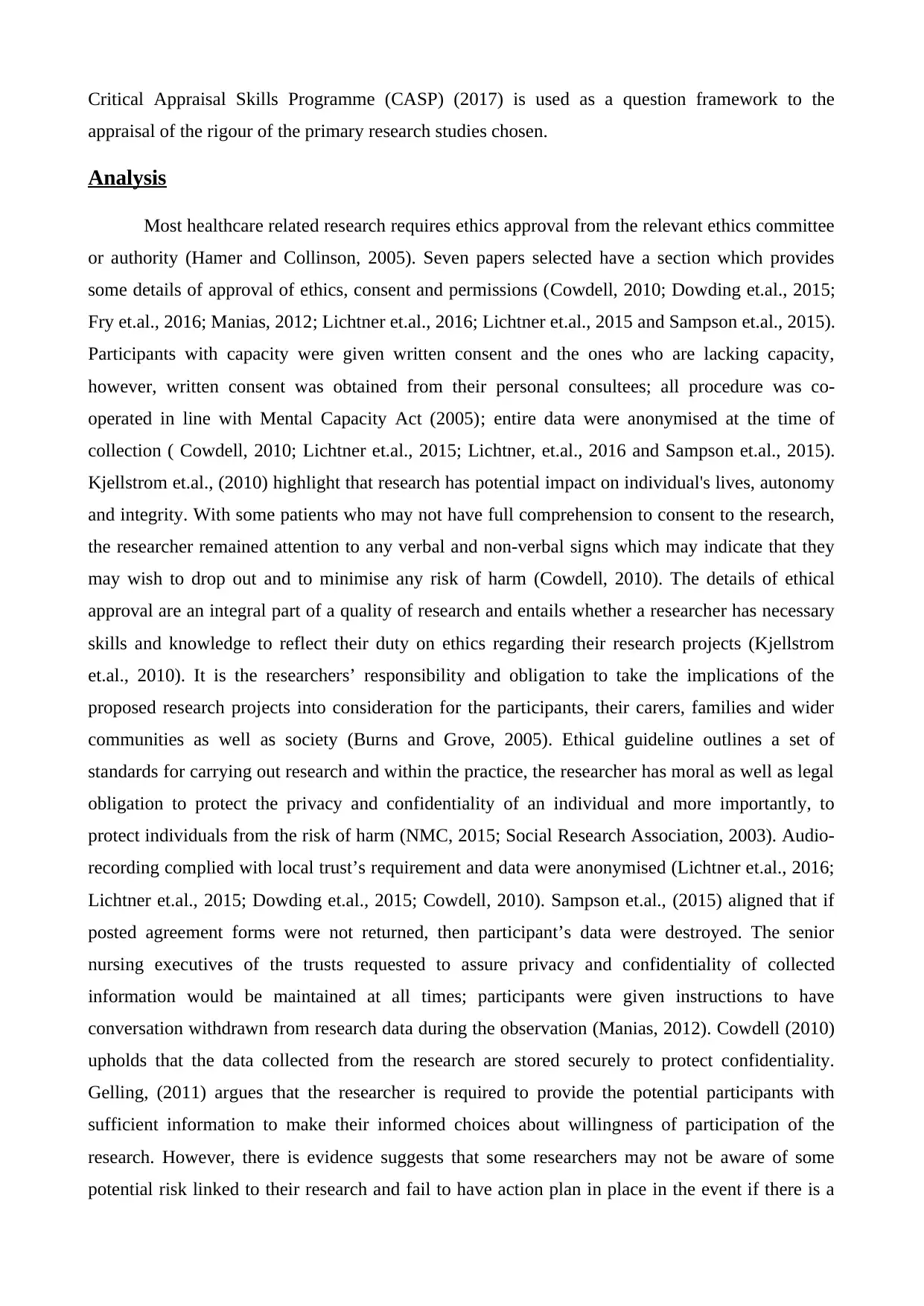
Critical Appraisal Skills Programme (CASP) (2017) is used as a question framework to the
appraisal of the rigour of the primary research studies chosen.
Analysis
Most healthcare related research requires ethics approval from the relevant ethics committee
or authority (Hamer and Collinson, 2005). Seven papers selected have a section which provides
some details of approval of ethics, consent and permissions (Cowdell, 2010; Dowding et.al., 2015;
Fry et.al., 2016; Manias, 2012; Lichtner et.al., 2016; Lichtner et.al., 2015 and Sampson et.al., 2015).
Participants with capacity were given written consent and the ones who are lacking capacity,
however, written consent was obtained from their personal consultees; all procedure was co-
operated in line with Mental Capacity Act (2005); entire data were anonymised at the time of
collection ( Cowdell, 2010; Lichtner et.al., 2015; Lichtner, et.al., 2016 and Sampson et.al., 2015).
Kjellstrom et.al., (2010) highlight that research has potential impact on individual's lives, autonomy
and integrity. With some patients who may not have full comprehension to consent to the research,
the researcher remained attention to any verbal and non-verbal signs which may indicate that they
may wish to drop out and to minimise any risk of harm (Cowdell, 2010). The details of ethical
approval are an integral part of a quality of research and entails whether a researcher has necessary
skills and knowledge to reflect their duty on ethics regarding their research projects (Kjellstrom
et.al., 2010). It is the researchers’ responsibility and obligation to take the implications of the
proposed research projects into consideration for the participants, their carers, families and wider
communities as well as society (Burns and Grove, 2005). Ethical guideline outlines a set of
standards for carrying out research and within the practice, the researcher has moral as well as legal
obligation to protect the privacy and confidentiality of an individual and more importantly, to
protect individuals from the risk of harm (NMC, 2015; Social Research Association, 2003). Audio-
recording complied with local trust’s requirement and data were anonymised (Lichtner et.al., 2016;
Lichtner et.al., 2015; Dowding et.al., 2015; Cowdell, 2010). Sampson et.al., (2015) aligned that if
posted agreement forms were not returned, then participant’s data were destroyed. The senior
nursing executives of the trusts requested to assure privacy and confidentiality of collected
information would be maintained at all times; participants were given instructions to have
conversation withdrawn from research data during the observation (Manias, 2012). Cowdell (2010)
upholds that the data collected from the research are stored securely to protect confidentiality.
Gelling, (2011) argues that the researcher is required to provide the potential participants with
sufficient information to make their informed choices about willingness of participation of the
research. However, there is evidence suggests that some researchers may not be aware of some
potential risk linked to their research and fail to have action plan in place in the event if there is a
appraisal of the rigour of the primary research studies chosen.
Analysis
Most healthcare related research requires ethics approval from the relevant ethics committee
or authority (Hamer and Collinson, 2005). Seven papers selected have a section which provides
some details of approval of ethics, consent and permissions (Cowdell, 2010; Dowding et.al., 2015;
Fry et.al., 2016; Manias, 2012; Lichtner et.al., 2016; Lichtner et.al., 2015 and Sampson et.al., 2015).
Participants with capacity were given written consent and the ones who are lacking capacity,
however, written consent was obtained from their personal consultees; all procedure was co-
operated in line with Mental Capacity Act (2005); entire data were anonymised at the time of
collection ( Cowdell, 2010; Lichtner et.al., 2015; Lichtner, et.al., 2016 and Sampson et.al., 2015).
Kjellstrom et.al., (2010) highlight that research has potential impact on individual's lives, autonomy
and integrity. With some patients who may not have full comprehension to consent to the research,
the researcher remained attention to any verbal and non-verbal signs which may indicate that they
may wish to drop out and to minimise any risk of harm (Cowdell, 2010). The details of ethical
approval are an integral part of a quality of research and entails whether a researcher has necessary
skills and knowledge to reflect their duty on ethics regarding their research projects (Kjellstrom
et.al., 2010). It is the researchers’ responsibility and obligation to take the implications of the
proposed research projects into consideration for the participants, their carers, families and wider
communities as well as society (Burns and Grove, 2005). Ethical guideline outlines a set of
standards for carrying out research and within the practice, the researcher has moral as well as legal
obligation to protect the privacy and confidentiality of an individual and more importantly, to
protect individuals from the risk of harm (NMC, 2015; Social Research Association, 2003). Audio-
recording complied with local trust’s requirement and data were anonymised (Lichtner et.al., 2016;
Lichtner et.al., 2015; Dowding et.al., 2015; Cowdell, 2010). Sampson et.al., (2015) aligned that if
posted agreement forms were not returned, then participant’s data were destroyed. The senior
nursing executives of the trusts requested to assure privacy and confidentiality of collected
information would be maintained at all times; participants were given instructions to have
conversation withdrawn from research data during the observation (Manias, 2012). Cowdell (2010)
upholds that the data collected from the research are stored securely to protect confidentiality.
Gelling, (2011) argues that the researcher is required to provide the potential participants with
sufficient information to make their informed choices about willingness of participation of the
research. However, there is evidence suggests that some researchers may not be aware of some
potential risk linked to their research and fail to have action plan in place in the event if there is a
Paraphrase This Document
Need a fresh take? Get an instant paraphrase of this document with our AI Paraphraser
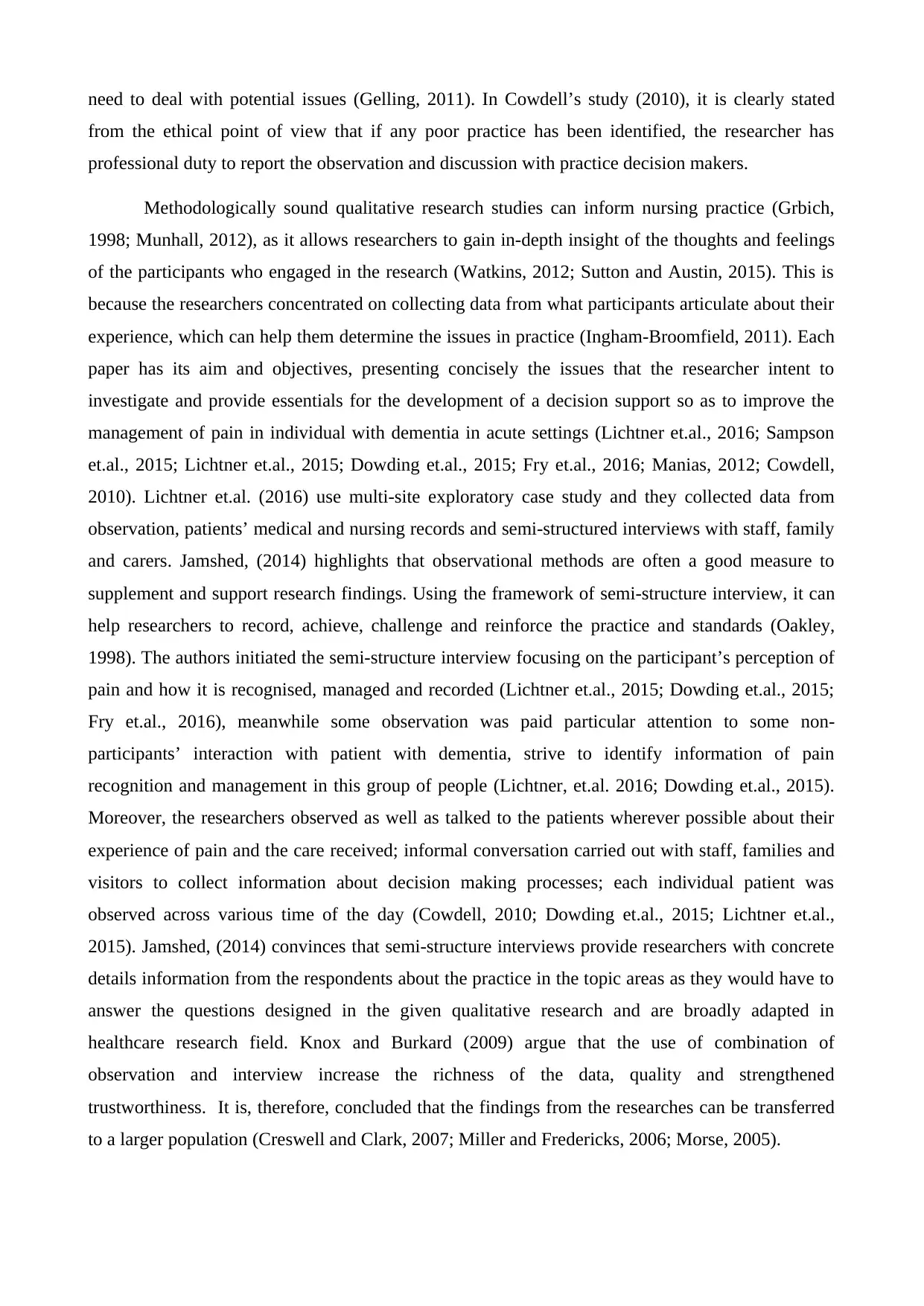
need to deal with potential issues (Gelling, 2011). In Cowdell’s study (2010), it is clearly stated
from the ethical point of view that if any poor practice has been identified, the researcher has
professional duty to report the observation and discussion with practice decision makers.
Methodologically sound qualitative research studies can inform nursing practice (Grbich,
1998; Munhall, 2012), as it allows researchers to gain in-depth insight of the thoughts and feelings
of the participants who engaged in the research (Watkins, 2012; Sutton and Austin, 2015). This is
because the researchers concentrated on collecting data from what participants articulate about their
experience, which can help them determine the issues in practice (Ingham-Broomfield, 2011). Each
paper has its aim and objectives, presenting concisely the issues that the researcher intent to
investigate and provide essentials for the development of a decision support so as to improve the
management of pain in individual with dementia in acute settings (Lichtner et.al., 2016; Sampson
et.al., 2015; Lichtner et.al., 2015; Dowding et.al., 2015; Fry et.al., 2016; Manias, 2012; Cowdell,
2010). Lichtner et.al. (2016) use multi-site exploratory case study and they collected data from
observation, patients’ medical and nursing records and semi-structured interviews with staff, family
and carers. Jamshed, (2014) highlights that observational methods are often a good measure to
supplement and support research findings. Using the framework of semi-structure interview, it can
help researchers to record, achieve, challenge and reinforce the practice and standards (Oakley,
1998). The authors initiated the semi-structure interview focusing on the participant’s perception of
pain and how it is recognised, managed and recorded (Lichtner et.al., 2015; Dowding et.al., 2015;
Fry et.al., 2016), meanwhile some observation was paid particular attention to some non-
participants’ interaction with patient with dementia, strive to identify information of pain
recognition and management in this group of people (Lichtner, et.al. 2016; Dowding et.al., 2015).
Moreover, the researchers observed as well as talked to the patients wherever possible about their
experience of pain and the care received; informal conversation carried out with staff, families and
visitors to collect information about decision making processes; each individual patient was
observed across various time of the day (Cowdell, 2010; Dowding et.al., 2015; Lichtner et.al.,
2015). Jamshed, (2014) convinces that semi-structure interviews provide researchers with concrete
details information from the respondents about the practice in the topic areas as they would have to
answer the questions designed in the given qualitative research and are broadly adapted in
healthcare research field. Knox and Burkard (2009) argue that the use of combination of
observation and interview increase the richness of the data, quality and strengthened
trustworthiness. It is, therefore, concluded that the findings from the researches can be transferred
to a larger population (Creswell and Clark, 2007; Miller and Fredericks, 2006; Morse, 2005).
from the ethical point of view that if any poor practice has been identified, the researcher has
professional duty to report the observation and discussion with practice decision makers.
Methodologically sound qualitative research studies can inform nursing practice (Grbich,
1998; Munhall, 2012), as it allows researchers to gain in-depth insight of the thoughts and feelings
of the participants who engaged in the research (Watkins, 2012; Sutton and Austin, 2015). This is
because the researchers concentrated on collecting data from what participants articulate about their
experience, which can help them determine the issues in practice (Ingham-Broomfield, 2011). Each
paper has its aim and objectives, presenting concisely the issues that the researcher intent to
investigate and provide essentials for the development of a decision support so as to improve the
management of pain in individual with dementia in acute settings (Lichtner et.al., 2016; Sampson
et.al., 2015; Lichtner et.al., 2015; Dowding et.al., 2015; Fry et.al., 2016; Manias, 2012; Cowdell,
2010). Lichtner et.al. (2016) use multi-site exploratory case study and they collected data from
observation, patients’ medical and nursing records and semi-structured interviews with staff, family
and carers. Jamshed, (2014) highlights that observational methods are often a good measure to
supplement and support research findings. Using the framework of semi-structure interview, it can
help researchers to record, achieve, challenge and reinforce the practice and standards (Oakley,
1998). The authors initiated the semi-structure interview focusing on the participant’s perception of
pain and how it is recognised, managed and recorded (Lichtner et.al., 2015; Dowding et.al., 2015;
Fry et.al., 2016), meanwhile some observation was paid particular attention to some non-
participants’ interaction with patient with dementia, strive to identify information of pain
recognition and management in this group of people (Lichtner, et.al. 2016; Dowding et.al., 2015).
Moreover, the researchers observed as well as talked to the patients wherever possible about their
experience of pain and the care received; informal conversation carried out with staff, families and
visitors to collect information about decision making processes; each individual patient was
observed across various time of the day (Cowdell, 2010; Dowding et.al., 2015; Lichtner et.al.,
2015). Jamshed, (2014) convinces that semi-structure interviews provide researchers with concrete
details information from the respondents about the practice in the topic areas as they would have to
answer the questions designed in the given qualitative research and are broadly adapted in
healthcare research field. Knox and Burkard (2009) argue that the use of combination of
observation and interview increase the richness of the data, quality and strengthened
trustworthiness. It is, therefore, concluded that the findings from the researches can be transferred
to a larger population (Creswell and Clark, 2007; Miller and Fredericks, 2006; Morse, 2005).
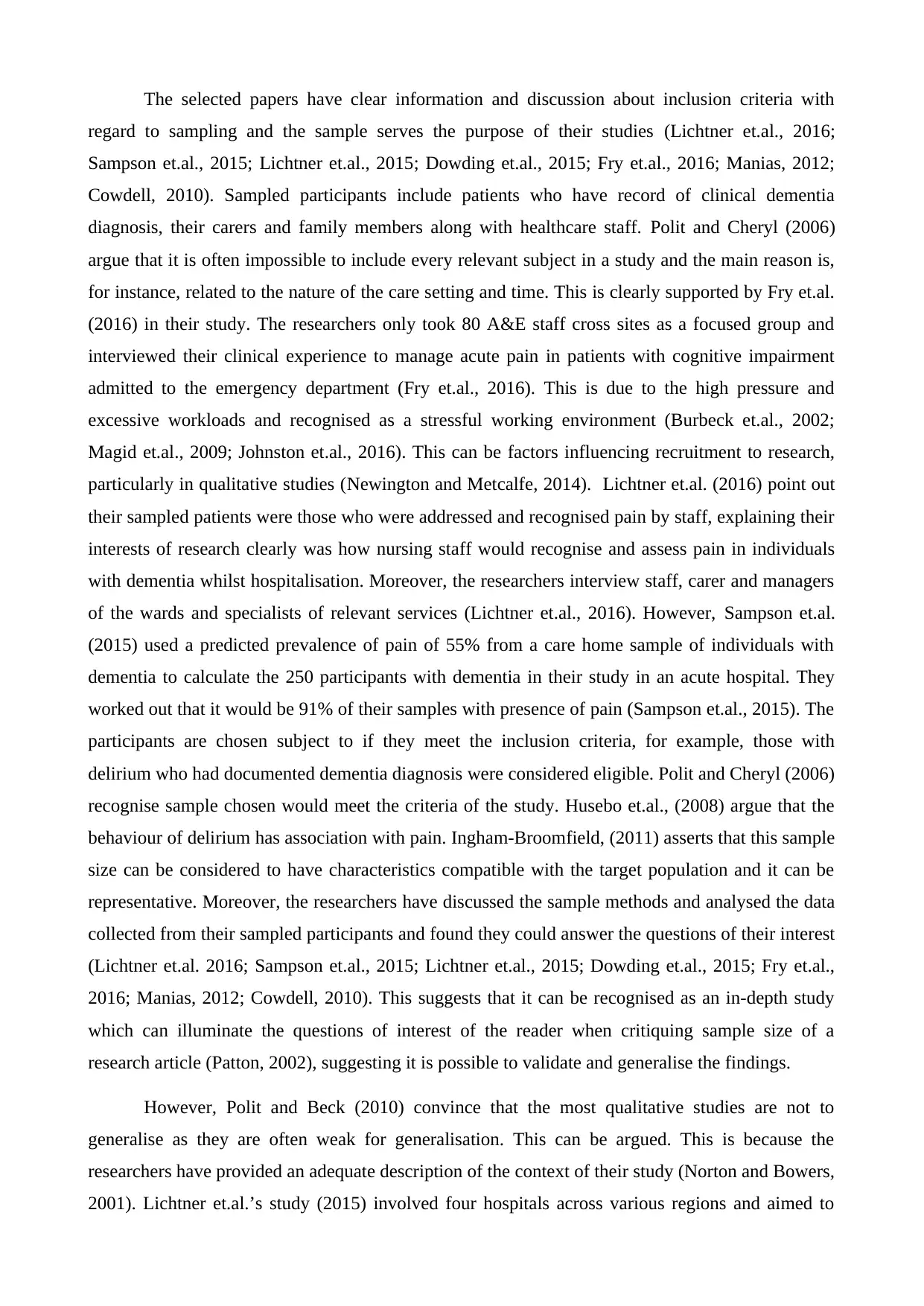
The selected papers have clear information and discussion about inclusion criteria with
regard to sampling and the sample serves the purpose of their studies (Lichtner et.al., 2016;
Sampson et.al., 2015; Lichtner et.al., 2015; Dowding et.al., 2015; Fry et.al., 2016; Manias, 2012;
Cowdell, 2010). Sampled participants include patients who have record of clinical dementia
diagnosis, their carers and family members along with healthcare staff. Polit and Cheryl (2006)
argue that it is often impossible to include every relevant subject in a study and the main reason is,
for instance, related to the nature of the care setting and time. This is clearly supported by Fry et.al.
(2016) in their study. The researchers only took 80 A&E staff cross sites as a focused group and
interviewed their clinical experience to manage acute pain in patients with cognitive impairment
admitted to the emergency department (Fry et.al., 2016). This is due to the high pressure and
excessive workloads and recognised as a stressful working environment (Burbeck et.al., 2002;
Magid et.al., 2009; Johnston et.al., 2016). This can be factors influencing recruitment to research,
particularly in qualitative studies (Newington and Metcalfe, 2014). Lichtner et.al. (2016) point out
their sampled patients were those who were addressed and recognised pain by staff, explaining their
interests of research clearly was how nursing staff would recognise and assess pain in individuals
with dementia whilst hospitalisation. Moreover, the researchers interview staff, carer and managers
of the wards and specialists of relevant services (Lichtner et.al., 2016). However, Sampson et.al.
(2015) used a predicted prevalence of pain of 55% from a care home sample of individuals with
dementia to calculate the 250 participants with dementia in their study in an acute hospital. They
worked out that it would be 91% of their samples with presence of pain (Sampson et.al., 2015). The
participants are chosen subject to if they meet the inclusion criteria, for example, those with
delirium who had documented dementia diagnosis were considered eligible. Polit and Cheryl (2006)
recognise sample chosen would meet the criteria of the study. Husebo et.al., (2008) argue that the
behaviour of delirium has association with pain. Ingham-Broomfield, (2011) asserts that this sample
size can be considered to have characteristics compatible with the target population and it can be
representative. Moreover, the researchers have discussed the sample methods and analysed the data
collected from their sampled participants and found they could answer the questions of their interest
(Lichtner et.al. 2016; Sampson et.al., 2015; Lichtner et.al., 2015; Dowding et.al., 2015; Fry et.al.,
2016; Manias, 2012; Cowdell, 2010). This suggests that it can be recognised as an in-depth study
which can illuminate the questions of interest of the reader when critiquing sample size of a
research article (Patton, 2002), suggesting it is possible to validate and generalise the findings.
However, Polit and Beck (2010) convince that the most qualitative studies are not to
generalise as they are often weak for generalisation. This can be argued. This is because the
researchers have provided an adequate description of the context of their study (Norton and Bowers,
2001). Lichtner et.al.’s study (2015) involved four hospitals across various regions and aimed to
regard to sampling and the sample serves the purpose of their studies (Lichtner et.al., 2016;
Sampson et.al., 2015; Lichtner et.al., 2015; Dowding et.al., 2015; Fry et.al., 2016; Manias, 2012;
Cowdell, 2010). Sampled participants include patients who have record of clinical dementia
diagnosis, their carers and family members along with healthcare staff. Polit and Cheryl (2006)
argue that it is often impossible to include every relevant subject in a study and the main reason is,
for instance, related to the nature of the care setting and time. This is clearly supported by Fry et.al.
(2016) in their study. The researchers only took 80 A&E staff cross sites as a focused group and
interviewed their clinical experience to manage acute pain in patients with cognitive impairment
admitted to the emergency department (Fry et.al., 2016). This is due to the high pressure and
excessive workloads and recognised as a stressful working environment (Burbeck et.al., 2002;
Magid et.al., 2009; Johnston et.al., 2016). This can be factors influencing recruitment to research,
particularly in qualitative studies (Newington and Metcalfe, 2014). Lichtner et.al. (2016) point out
their sampled patients were those who were addressed and recognised pain by staff, explaining their
interests of research clearly was how nursing staff would recognise and assess pain in individuals
with dementia whilst hospitalisation. Moreover, the researchers interview staff, carer and managers
of the wards and specialists of relevant services (Lichtner et.al., 2016). However, Sampson et.al.
(2015) used a predicted prevalence of pain of 55% from a care home sample of individuals with
dementia to calculate the 250 participants with dementia in their study in an acute hospital. They
worked out that it would be 91% of their samples with presence of pain (Sampson et.al., 2015). The
participants are chosen subject to if they meet the inclusion criteria, for example, those with
delirium who had documented dementia diagnosis were considered eligible. Polit and Cheryl (2006)
recognise sample chosen would meet the criteria of the study. Husebo et.al., (2008) argue that the
behaviour of delirium has association with pain. Ingham-Broomfield, (2011) asserts that this sample
size can be considered to have characteristics compatible with the target population and it can be
representative. Moreover, the researchers have discussed the sample methods and analysed the data
collected from their sampled participants and found they could answer the questions of their interest
(Lichtner et.al. 2016; Sampson et.al., 2015; Lichtner et.al., 2015; Dowding et.al., 2015; Fry et.al.,
2016; Manias, 2012; Cowdell, 2010). This suggests that it can be recognised as an in-depth study
which can illuminate the questions of interest of the reader when critiquing sample size of a
research article (Patton, 2002), suggesting it is possible to validate and generalise the findings.
However, Polit and Beck (2010) convince that the most qualitative studies are not to
generalise as they are often weak for generalisation. This can be argued. This is because the
researchers have provided an adequate description of the context of their study (Norton and Bowers,
2001). Lichtner et.al.’s study (2015) involved four hospitals across various regions and aimed to
⊘ This is a preview!⊘
Do you want full access?
Subscribe today to unlock all pages.

Trusted by 1+ million students worldwide
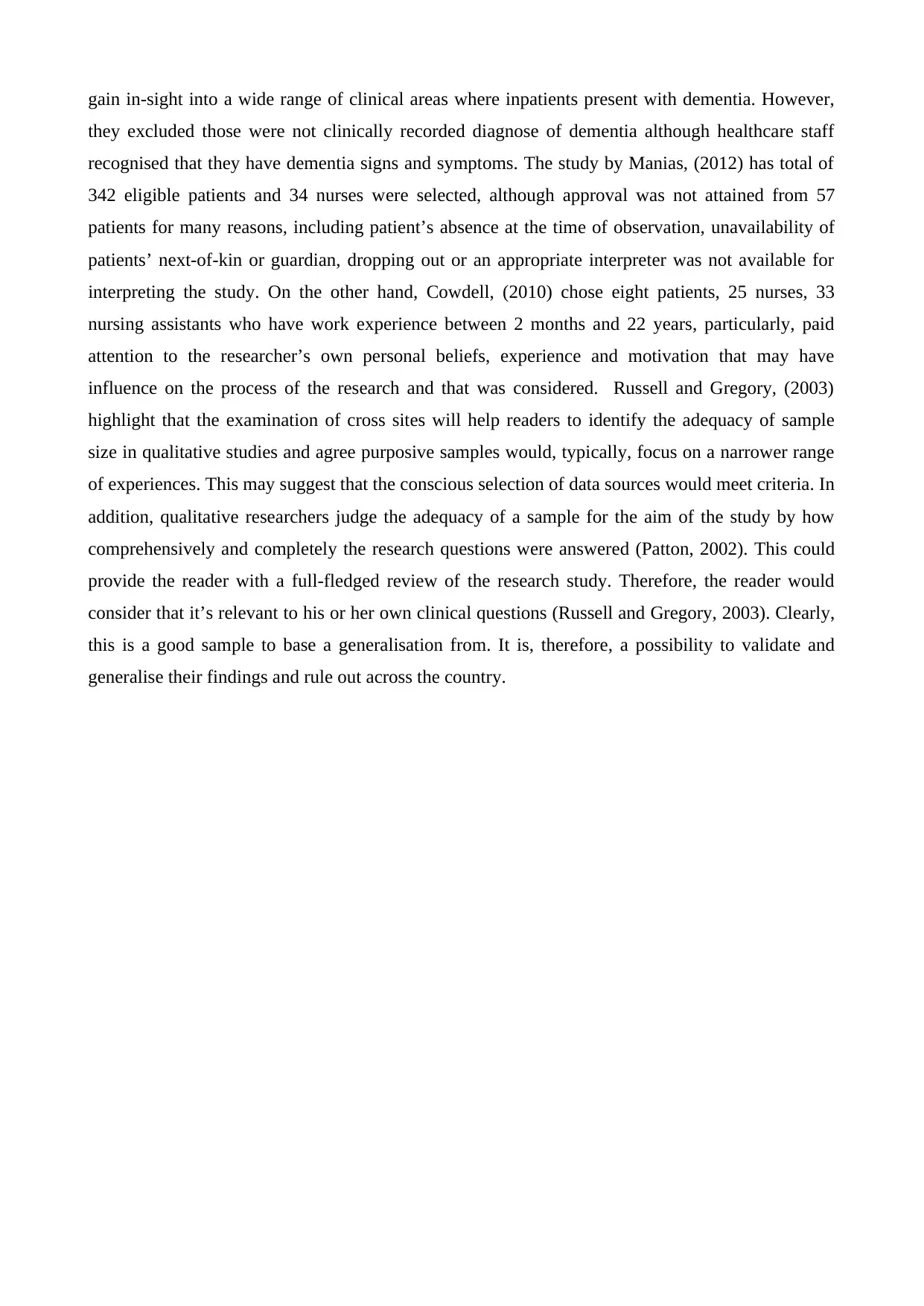
gain in-sight into a wide range of clinical areas where inpatients present with dementia. However,
they excluded those were not clinically recorded diagnose of dementia although healthcare staff
recognised that they have dementia signs and symptoms. The study by Manias, (2012) has total of
342 eligible patients and 34 nurses were selected, although approval was not attained from 57
patients for many reasons, including patient’s absence at the time of observation, unavailability of
patients’ next-of-kin or guardian, dropping out or an appropriate interpreter was not available for
interpreting the study. On the other hand, Cowdell, (2010) chose eight patients, 25 nurses, 33
nursing assistants who have work experience between 2 months and 22 years, particularly, paid
attention to the researcher’s own personal beliefs, experience and motivation that may have
influence on the process of the research and that was considered. Russell and Gregory, (2003)
highlight that the examination of cross sites will help readers to identify the adequacy of sample
size in qualitative studies and agree purposive samples would, typically, focus on a narrower range
of experiences. This may suggest that the conscious selection of data sources would meet criteria. In
addition, qualitative researchers judge the adequacy of a sample for the aim of the study by how
comprehensively and completely the research questions were answered (Patton, 2002). This could
provide the reader with a full-fledged review of the research study. Therefore, the reader would
consider that it’s relevant to his or her own clinical questions (Russell and Gregory, 2003). Clearly,
this is a good sample to base a generalisation from. It is, therefore, a possibility to validate and
generalise their findings and rule out across the country.
they excluded those were not clinically recorded diagnose of dementia although healthcare staff
recognised that they have dementia signs and symptoms. The study by Manias, (2012) has total of
342 eligible patients and 34 nurses were selected, although approval was not attained from 57
patients for many reasons, including patient’s absence at the time of observation, unavailability of
patients’ next-of-kin or guardian, dropping out or an appropriate interpreter was not available for
interpreting the study. On the other hand, Cowdell, (2010) chose eight patients, 25 nurses, 33
nursing assistants who have work experience between 2 months and 22 years, particularly, paid
attention to the researcher’s own personal beliefs, experience and motivation that may have
influence on the process of the research and that was considered. Russell and Gregory, (2003)
highlight that the examination of cross sites will help readers to identify the adequacy of sample
size in qualitative studies and agree purposive samples would, typically, focus on a narrower range
of experiences. This may suggest that the conscious selection of data sources would meet criteria. In
addition, qualitative researchers judge the adequacy of a sample for the aim of the study by how
comprehensively and completely the research questions were answered (Patton, 2002). This could
provide the reader with a full-fledged review of the research study. Therefore, the reader would
consider that it’s relevant to his or her own clinical questions (Russell and Gregory, 2003). Clearly,
this is a good sample to base a generalisation from. It is, therefore, a possibility to validate and
generalise their findings and rule out across the country.
Paraphrase This Document
Need a fresh take? Get an instant paraphrase of this document with our AI Paraphraser
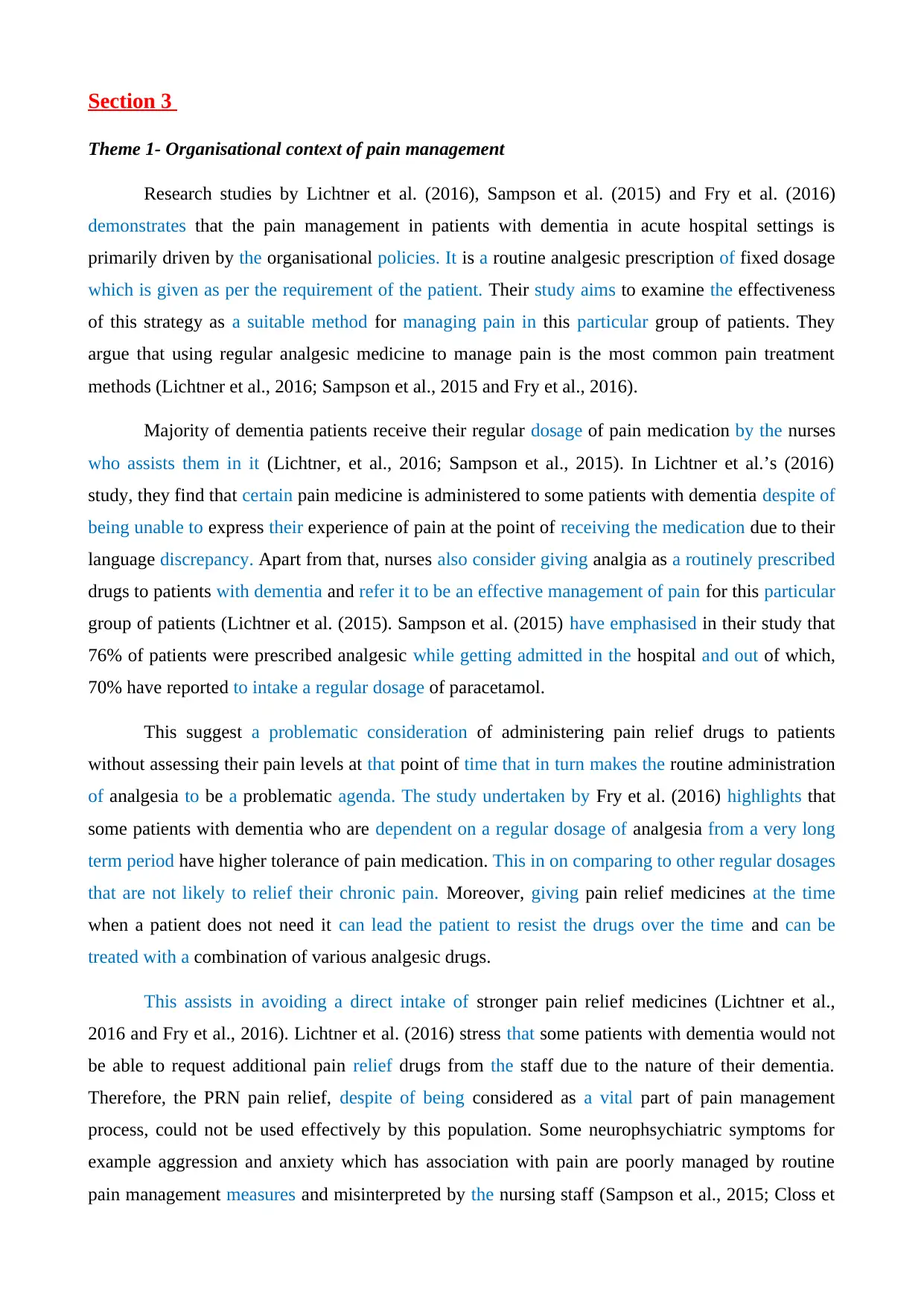
Section 3
Theme 1- Organisational context of pain management
Research studies by Lichtner et al. (2016), Sampson et al. (2015) and Fry et al. (2016)
demonstrates that the pain management in patients with dementia in acute hospital settings is
primarily driven by the organisational policies. It is a routine analgesic prescription of fixed dosage
which is given as per the requirement of the patient. Their study aims to examine the effectiveness
of this strategy as a suitable method for managing pain in this particular group of patients. They
argue that using regular analgesic medicine to manage pain is the most common pain treatment
methods (Lichtner et al., 2016; Sampson et al., 2015 and Fry et al., 2016).
Majority of dementia patients receive their regular dosage of pain medication by the nurses
who assists them in it (Lichtner, et al., 2016; Sampson et al., 2015). In Lichtner et al.’s (2016)
study, they find that certain pain medicine is administered to some patients with dementia despite of
being unable to express their experience of pain at the point of receiving the medication due to their
language discrepancy. Apart from that, nurses also consider giving analgia as a routinely prescribed
drugs to patients with dementia and refer it to be an effective management of pain for this particular
group of patients (Lichtner et al. (2015). Sampson et al. (2015) have emphasised in their study that
76% of patients were prescribed analgesic while getting admitted in the hospital and out of which,
70% have reported to intake a regular dosage of paracetamol.
This suggest a problematic consideration of administering pain relief drugs to patients
without assessing their pain levels at that point of time that in turn makes the routine administration
of analgesia to be a problematic agenda. The study undertaken by Fry et al. (2016) highlights that
some patients with dementia who are dependent on a regular dosage of analgesia from a very long
term period have higher tolerance of pain medication. This in on comparing to other regular dosages
that are not likely to relief their chronic pain. Moreover, giving pain relief medicines at the time
when a patient does not need it can lead the patient to resist the drugs over the time and can be
treated with a combination of various analgesic drugs.
This assists in avoiding a direct intake of stronger pain relief medicines (Lichtner et al.,
2016 and Fry et al., 2016). Lichtner et al. (2016) stress that some patients with dementia would not
be able to request additional pain relief drugs from the staff due to the nature of their dementia.
Therefore, the PRN pain relief, despite of being considered as a vital part of pain management
process, could not be used effectively by this population. Some neurophsychiatric symptoms for
example aggression and anxiety which has association with pain are poorly managed by routine
pain management measures and misinterpreted by the nursing staff (Sampson et al., 2015; Closs et
Theme 1- Organisational context of pain management
Research studies by Lichtner et al. (2016), Sampson et al. (2015) and Fry et al. (2016)
demonstrates that the pain management in patients with dementia in acute hospital settings is
primarily driven by the organisational policies. It is a routine analgesic prescription of fixed dosage
which is given as per the requirement of the patient. Their study aims to examine the effectiveness
of this strategy as a suitable method for managing pain in this particular group of patients. They
argue that using regular analgesic medicine to manage pain is the most common pain treatment
methods (Lichtner et al., 2016; Sampson et al., 2015 and Fry et al., 2016).
Majority of dementia patients receive their regular dosage of pain medication by the nurses
who assists them in it (Lichtner, et al., 2016; Sampson et al., 2015). In Lichtner et al.’s (2016)
study, they find that certain pain medicine is administered to some patients with dementia despite of
being unable to express their experience of pain at the point of receiving the medication due to their
language discrepancy. Apart from that, nurses also consider giving analgia as a routinely prescribed
drugs to patients with dementia and refer it to be an effective management of pain for this particular
group of patients (Lichtner et al. (2015). Sampson et al. (2015) have emphasised in their study that
76% of patients were prescribed analgesic while getting admitted in the hospital and out of which,
70% have reported to intake a regular dosage of paracetamol.
This suggest a problematic consideration of administering pain relief drugs to patients
without assessing their pain levels at that point of time that in turn makes the routine administration
of analgesia to be a problematic agenda. The study undertaken by Fry et al. (2016) highlights that
some patients with dementia who are dependent on a regular dosage of analgesia from a very long
term period have higher tolerance of pain medication. This in on comparing to other regular dosages
that are not likely to relief their chronic pain. Moreover, giving pain relief medicines at the time
when a patient does not need it can lead the patient to resist the drugs over the time and can be
treated with a combination of various analgesic drugs.
This assists in avoiding a direct intake of stronger pain relief medicines (Lichtner et al.,
2016 and Fry et al., 2016). Lichtner et al. (2016) stress that some patients with dementia would not
be able to request additional pain relief drugs from the staff due to the nature of their dementia.
Therefore, the PRN pain relief, despite of being considered as a vital part of pain management
process, could not be used effectively by this population. Some neurophsychiatric symptoms for
example aggression and anxiety which has association with pain are poorly managed by routine
pain management measures and misinterpreted by the nursing staff (Sampson et al., 2015; Closs et
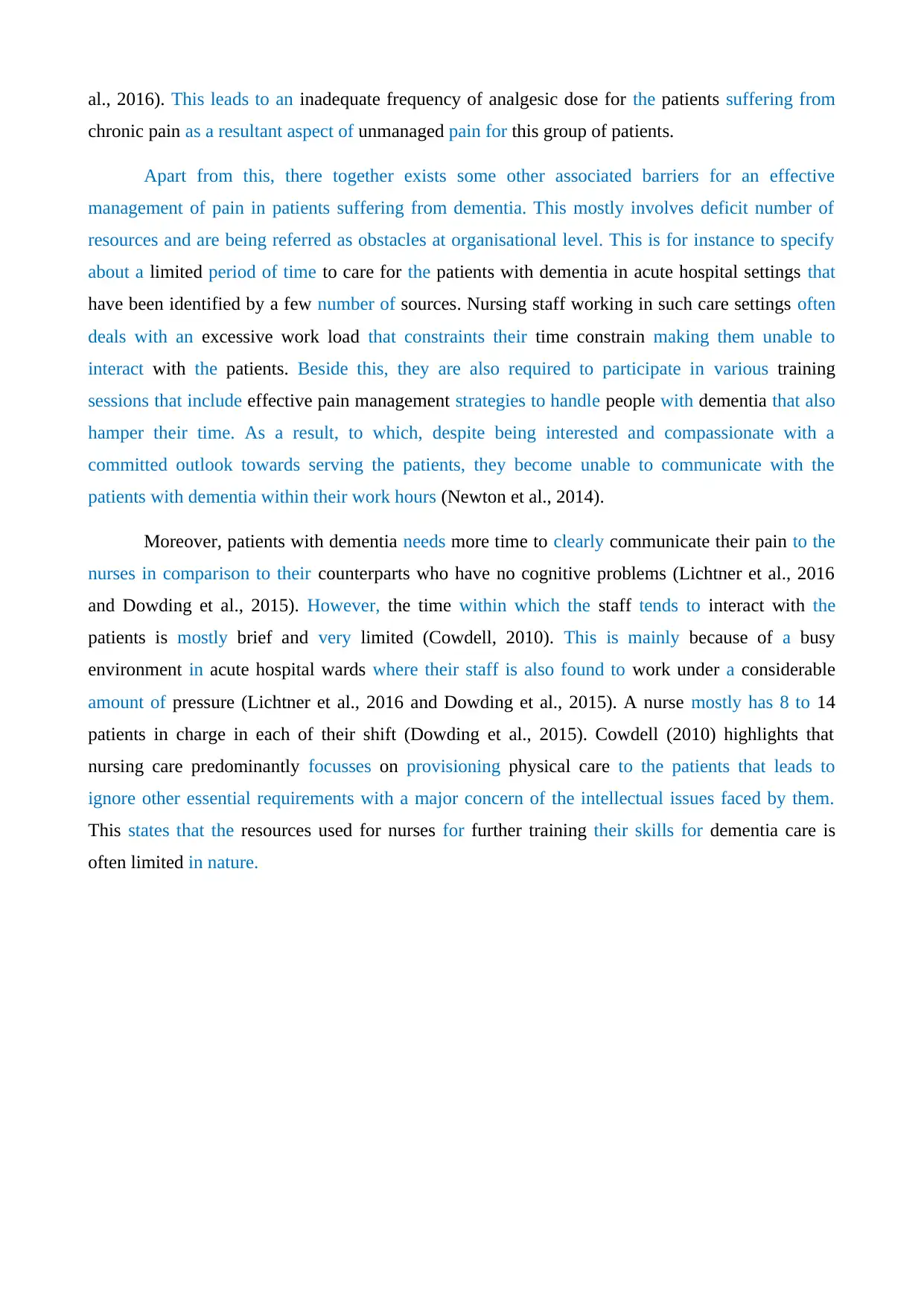
al., 2016). This leads to an inadequate frequency of analgesic dose for the patients suffering from
chronic pain as a resultant aspect of unmanaged pain for this group of patients.
Apart from this, there together exists some other associated barriers for an effective
management of pain in patients suffering from dementia. This mostly involves deficit number of
resources and are being referred as obstacles at organisational level. This is for instance to specify
about a limited period of time to care for the patients with dementia in acute hospital settings that
have been identified by a few number of sources. Nursing staff working in such care settings often
deals with an excessive work load that constraints their time constrain making them unable to
interact with the patients. Beside this, they are also required to participate in various training
sessions that include effective pain management strategies to handle people with dementia that also
hamper their time. As a result, to which, despite being interested and compassionate with a
committed outlook towards serving the patients, they become unable to communicate with the
patients with dementia within their work hours (Newton et al., 2014).
Moreover, patients with dementia needs more time to clearly communicate their pain to the
nurses in comparison to their counterparts who have no cognitive problems (Lichtner et al., 2016
and Dowding et al., 2015). However, the time within which the staff tends to interact with the
patients is mostly brief and very limited (Cowdell, 2010). This is mainly because of a busy
environment in acute hospital wards where their staff is also found to work under a considerable
amount of pressure (Lichtner et al., 2016 and Dowding et al., 2015). A nurse mostly has 8 to 14
patients in charge in each of their shift (Dowding et al., 2015). Cowdell (2010) highlights that
nursing care predominantly focusses on provisioning physical care to the patients that leads to
ignore other essential requirements with a major concern of the intellectual issues faced by them.
This states that the resources used for nurses for further training their skills for dementia care is
often limited in nature.
chronic pain as a resultant aspect of unmanaged pain for this group of patients.
Apart from this, there together exists some other associated barriers for an effective
management of pain in patients suffering from dementia. This mostly involves deficit number of
resources and are being referred as obstacles at organisational level. This is for instance to specify
about a limited period of time to care for the patients with dementia in acute hospital settings that
have been identified by a few number of sources. Nursing staff working in such care settings often
deals with an excessive work load that constraints their time constrain making them unable to
interact with the patients. Beside this, they are also required to participate in various training
sessions that include effective pain management strategies to handle people with dementia that also
hamper their time. As a result, to which, despite being interested and compassionate with a
committed outlook towards serving the patients, they become unable to communicate with the
patients with dementia within their work hours (Newton et al., 2014).
Moreover, patients with dementia needs more time to clearly communicate their pain to the
nurses in comparison to their counterparts who have no cognitive problems (Lichtner et al., 2016
and Dowding et al., 2015). However, the time within which the staff tends to interact with the
patients is mostly brief and very limited (Cowdell, 2010). This is mainly because of a busy
environment in acute hospital wards where their staff is also found to work under a considerable
amount of pressure (Lichtner et al., 2016 and Dowding et al., 2015). A nurse mostly has 8 to 14
patients in charge in each of their shift (Dowding et al., 2015). Cowdell (2010) highlights that
nursing care predominantly focusses on provisioning physical care to the patients that leads to
ignore other essential requirements with a major concern of the intellectual issues faced by them.
This states that the resources used for nurses for further training their skills for dementia care is
often limited in nature.
⊘ This is a preview!⊘
Do you want full access?
Subscribe today to unlock all pages.

Trusted by 1+ million students worldwide
1 out of 20
Related Documents
Your All-in-One AI-Powered Toolkit for Academic Success.
+13062052269
info@desklib.com
Available 24*7 on WhatsApp / Email
![[object Object]](/_next/static/media/star-bottom.7253800d.svg)
Unlock your academic potential
Copyright © 2020–2025 A2Z Services. All Rights Reserved. Developed and managed by ZUCOL.





